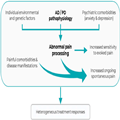Abstract and Introduction
Introduction
The effects of neurodegeneration on the experience of pain remain poorly understood, despite the risk of suffering from both pain and neurodegenerative diseases rising concurrently with age.[63,75] Given the anticipated increase in magnitude and median age of the global population,[76,152] the interaction of these 2 clinically unmet needs will become an increasingly pressing challenge. In particular, a significant proportion of patients with Alzheimer disease (AD) and Parkinson disease (PD), the 2 most prevalent neurodegenerative diseases, suffer chronic pain of variable origin (Box 1). As such, they have been the most extensively studied and, for brevity, will be the focus of this review. Persistent pain in AD and PD is partially attributable to various concomitant disease manifestations and comorbidities (Figure 1).[43,117] In addition, disease-specific neurodegenerative changes may affect a multitude of regions implicated in the perceptual and cognitive processes underlying pain. Despite this, the precise perceptual sequelae of neurodegenerative pathophysiology in these 2 diseases remain equivocal, and whether this may result in differential responses to analgesic treatment remains largely unexplored.
Figure 1.
Conceptual framework relating the respective neurodegenerative pathophysiology within AD and PD to pain processing and treatment. AD, Alzheimer disease; PD, Parkinson disease.
Three key principles lay conceptual foundations for the investigation of the effects of neurodegenerative pathophysiology on treatment mechanisms: (1) a given intensity of stimulus produces heterogeneous levels of reported pain and unpleasantness,[30,60,110,109,111,154] (2) genetic and environmental factors predispose some to chronic pain,[1,47,48,87] and (3) diversity of pain physiology and pathophysiology results in heterogeneous responses to pharmacotherapy.[46,100,134,153] Collectively, these support the notion that heterogeneous physiology and pathophysiology can give rise to divergent treatment responses. Within this framework, neurodegeneration and its effects on the central nervous system can be considered as one such external factor contributing to heterogeneity, resulting in putative perturbation of pain processing (1 and 2) and responses to analgesic treatments (3) (Figure 1).
Chronic pain in AD and PD not only impacts patients’ quality of life but also presents a formidable healthcare and socioeconomic challenge. Drugs available for treatment of chronic pain are associated with high numbers needed to treat and may have serious side effects.[145] Moreover, poorly managed pain is associated with depression,[33] anxiety,[139] and functional loss.[38] Given the high prevalence of pain and frailty in these patient groups, clear scientific rationale is imperative to ensure safe and effective clinical management (Figure 2). In this article, we discuss pain processing and perception in AD and PD as well as its emerging relevance to pharmacological treatment.
Figure 2.
Importance of mechanistic research for evidence-based pain medicine.



